Chapter 8 - Variation in Chromosome Structure and Number
1/44
Earn XP
Name | Mastery | Learn | Test | Matching | Spaced |
|---|
No study sessions yet.
45 Terms
Cytogenetics
The field of genetics that involves the microscopic examination of chromosomes. Someone in this field will typically examine the chromosomal composition of a particular cell or organism, allowing for detection of individuals with abnormal chromosome number or structure and differentiation between species.
1) Centromere location
2) Size
3) Banding pattern
What three main features are used by cytogeneticists to identify and classify chromosomes?
Karyotype
A micrograph in which all of the chromosomes within a single cell are arranged in a standard fashion.
G-Banding
Since different chromosomes can be very similar in size and centromere position, chromosomes are treated with stains to produce characteristic banding patterns, such as in this technique. This involves exposing chromosomes to the dye Giemsa; some regions bind the dye heavily and produce dark bands while other regions don’t bind the dye well and produce light bands.
1) Distinguishes individual chromosomes from each other
2) Detects changes in chromosome structure
3) Reveals evolutionary relationships among the chromosomes of closely related species
What are three ways in which banding patterns are useful?
Inversion
A change in the direction of part of the genetic material along a single chromosome.
In this change to chromosome structure, the total amount of genetic info stays the same, so a great majority of inversions have no phenotypic consequences.
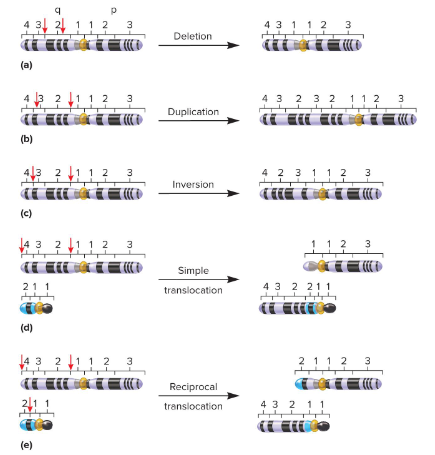
Duplication
The repetition of a chromosomal segment compared to a normal chromosome.
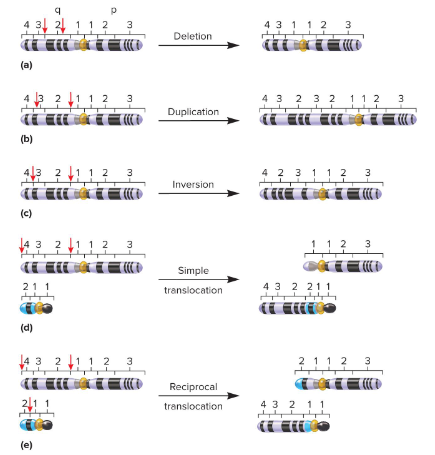
Deletion (Deficiency)
The loss of a chromosomal segment.
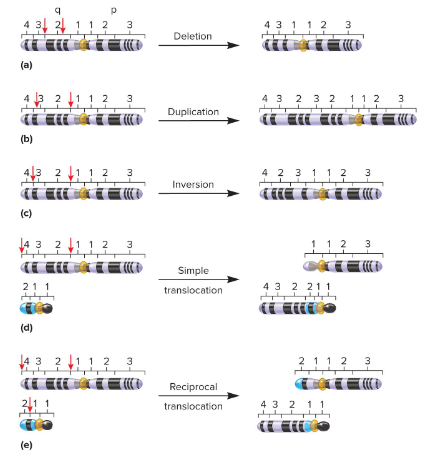
Translocation
A segment of one chromosome becomes attached to a different chromosome.
Simple Translocation
A piece of a chromosome is attached to another chromosome.
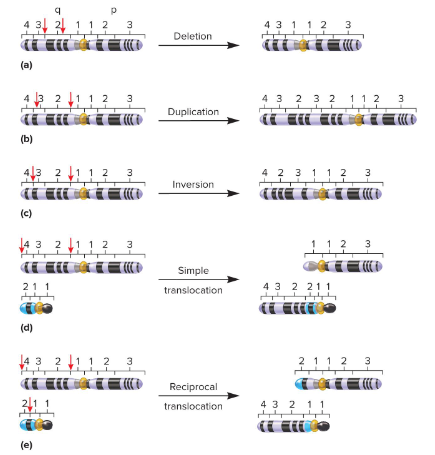
Reciprocal Translocation
Two different types of chromosomes exchange pieces, producing two abnormal chromosomes with translocations.

Terminal Deletion
When a chromosome is broken into two pieces (single break), the part without the centromere is eventually lost and the remaining chromosome is said to have this deletion.
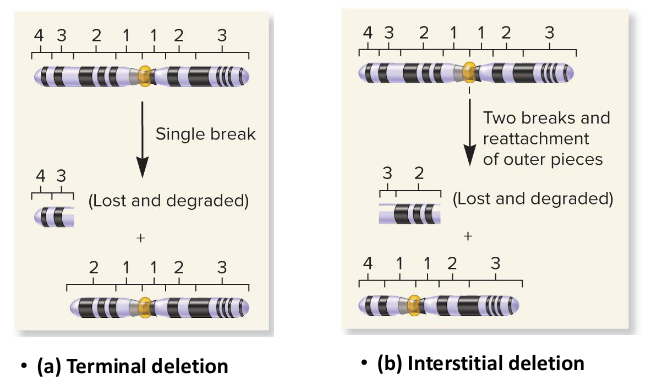
Interstitial Deletion
When a chromosome breaks in two places, the central fragment is lost and the two outer pieces reattach, forming a chromosome with this type of deletion.

1) Size of the deletion
2) What chromosomal material was deleted
The phenotypic consequences of deletions depends on what two factors?
Often if a deletion has a phenotypic consequences, they are usually detrimental (ex. cri-du-chat syndrome)
Recombination / nonallelic homologous recombination
Fill in the blank…
A chromosomal duplication is usually caused by abnormal events during ( ). Repetitive sequences can cause misalignment between homologous chromosomes. If a crossover occurs, ( ) results.
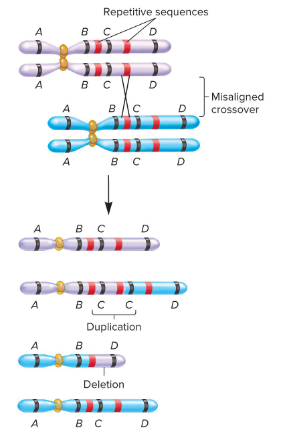
Size / less
Fill in the blank…
Like deletions, phenotypic consequences of duplications tend to be correlated to ( ). They are more likely to have phenotypic effects if they involve a large piece of the chromosome. However, duplications tend to have ( ) harmful effects than deletions of comparable size.
Gene Family
This consists of two or more genes in a single species that are derived from the same ancestral gene. These can be formed as a result of chromosome duplications. Duplicated genes may accumulate mutations that alter their function, resulting in similar yet distinct functions.
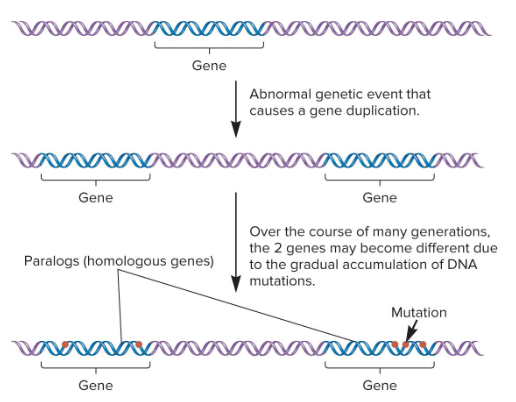
Paralogs
Homologous genes within a single species.
Ex) Globin gene family - globin genes all encode subunits of proteins that bind oxygen. Over thousands of years, the ancestral globin gene has been duplicated and altered so that there are now 14 versions of the gene in this gene family on three different chromosomes. They are each expressed at different times during development depending on the organism’s oxygen needs.
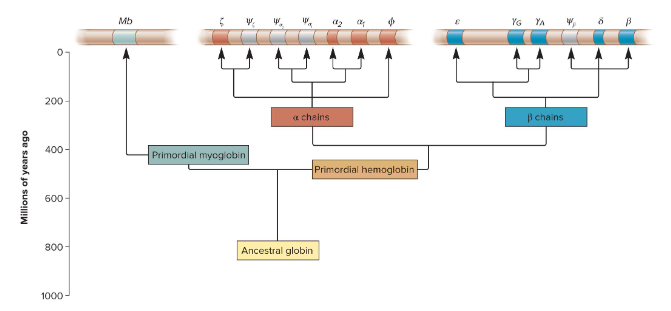
Copy Number Variation (CNV)
A segment of DNA that varies in copy number among members of the same species. It may be missing a particular gene or may be a duplication. They are surprisingly common in animals and plants.
It may be caused by nonallelic homologous recombination, proliferation of transposable elements, or errors in DNA replication.
It is associated with schizophrenia, autism and other learning disabilities, susceptibility to infectious diseases, and cancer.
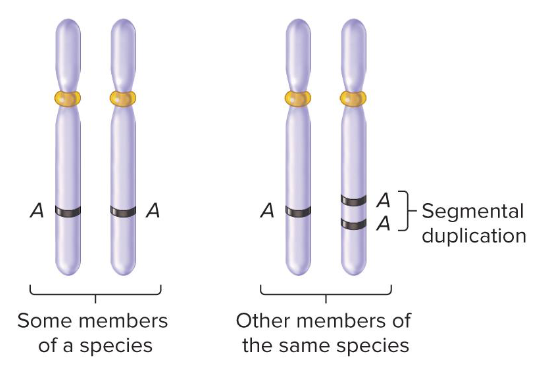
Pericentric Inversion
An inversion in which the inverted region contains the centromere.

Paracentric Inversion
An inversion in which the inverted region does not contain the centromere and is on one of either side of the chromosome.
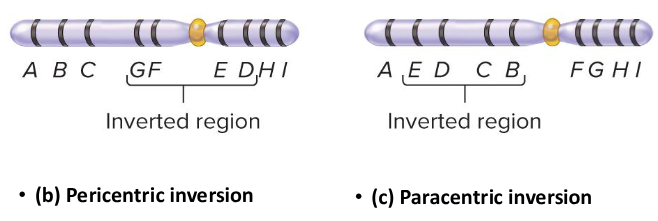
Break Point Effect
When an inversion break point occurs within a vital gene, there by separating it into 2 non-functional parts.
Position Effects
When a gene is repositioned in a way that alters its gene expression.
Ex) May be placed close to regulatory elements for another gene.
Inversion Heterozygotes
Individuals with one copy of a normal chromosome and one copy of an inverted chromosome. Some of these individuals may be phenotypically normal, but they have a higher probability of producing gametes that are abnormal in their total genetic content due to crossing over within the inverted segment.
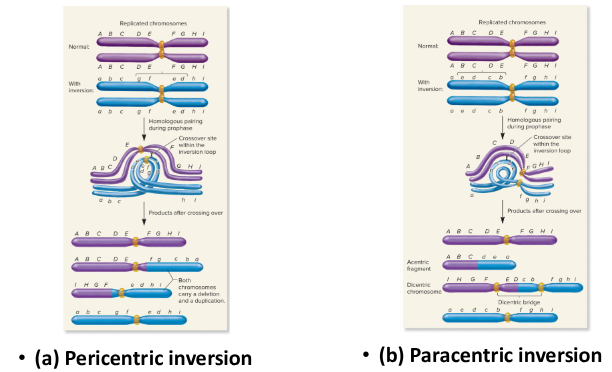
1) Chromosome breakage and DNA repair
2) Abnormal crossovers (non-homologous)
Reciprocal translocations arise from what two mechanisms?
Balanced Translocations
Another term for reciprocal translocations. They are also called these because they lead to a rearrangement of genetic material, not a change in the total amount. As such, reciprocal translocations are usually without phenotypic consequences, but they may result in a breakpoint or position effect.
Also, individuals carrying these translocations have a greater risk of producing gametes with unbalanced combinations of chromosomes depending on the segregation pattern during meiosis 1 (for segregation to occur properly, a translocation cross must form between the homologous chromosomes in order for them to synapse properly)
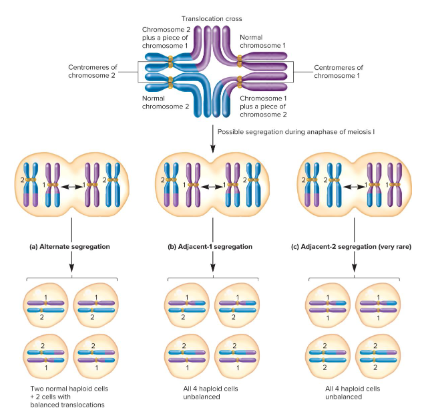
Unbalanced Translocations
Translocations that are not reciprocal that alter the total amount of genetic material. They often duplicate or delete material. Unlike reciprocal translocations, these are associated with phenotypic abnormalities.
Ex) Familial down syndrome → majority of chromosome 21 is attached to chromosome 14, so offspring may have three copies of genes found on a large segment of chromosome 21.
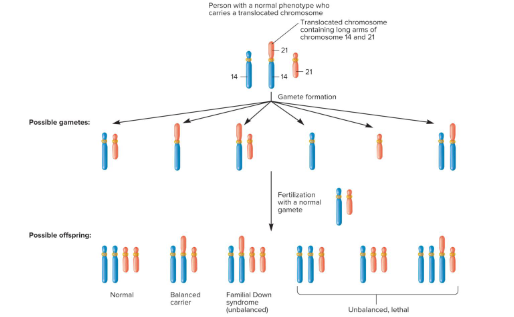
Euploidy
Variation in the number of complete sets of chromosomes. In animals, changes in this are not tolerated and are thus lethal since most species are diploid.
Ex) Organisms with 3 or more sets of chromosomes are called polyploid.
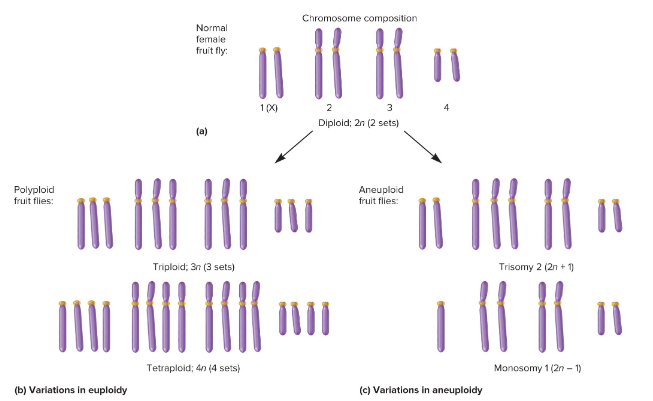
Aneuploidy
Variation in the number of particular chromosomes within a set. Commonly causes an abnormal phenotype, leading to an imbalance in the amount of gene products (may cause more or less gene product to form, leading to detrimental effects that decrease survival).
Ex) If an organism has 3 copies of a chromosome instead of 2, it is said to be trisomic for that chromosome. If an organism has 1 copy of a chromosome instead of 2, it is said to be monosomic for that chromosome.
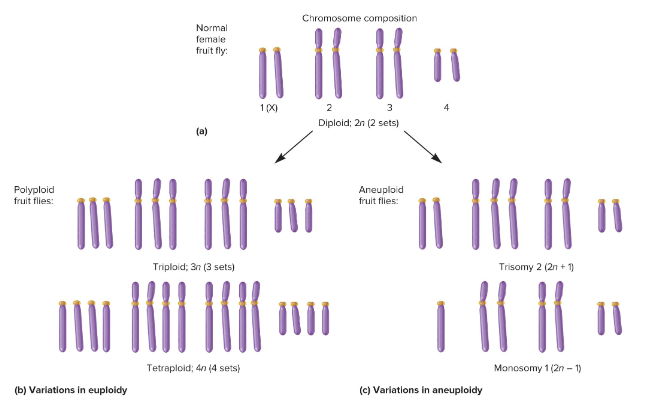
Small / fewer / sex / X-chromosome inactivation
Fill in the blank…
The autosomal aneuploidies compatible with survival are trisomies 13, 18, and 21. These involve chromosomes that are relatively ( ) and carry ( ) genes. Aneuploidies involving ( ) chromosomes generally have less severe effects due to ( ).
1) Expression of X-linked genes prior to embryonic X-chromosome inactivation
2) An imbalance in the expression of pseudoautosomal genes
Phenotypic effects of certain aneuploidies may be due to what two factors?
Human primary oocytes are produced in the ovary of the female fetus prior to birth. They are arrested in prophase of meiosis 1 until ovulation. As a woman ages, her primary oocytes have been arrested in prophase 1 for a progressively long time, leading to increased frequency of nondisjunction or improper separation of chromosomes.
Why is Down Syndrome correlated with offspring from older mothers?
Endopolyploidy
When diploid animals sometimes produce tissues that are polyploid.
Ex) Liver cells may be triploid, tetraploid, or even octaploid and enhance ability of a cell to produce specific gene products.
Polytene Chromosome
When chromosomes undergo repeated rounds of chromosome replication without cellular division, these bundles of chromosomes are produced and lie together in a parallel fashion.
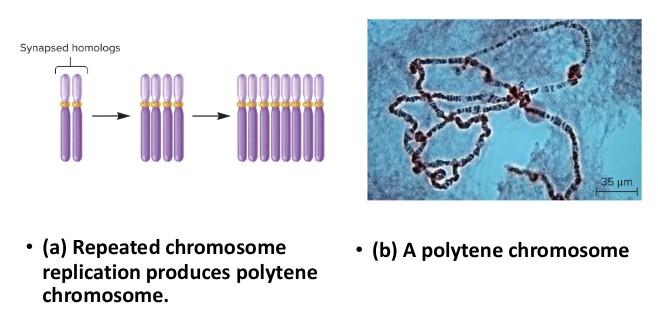
Chromocenter
The central point of a polytene chromosome where the chromosomes aggregate.
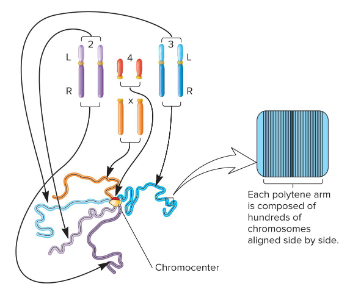
Sterile / aneuploid
Fill in the blank…
Unlike animals, many plants are polyploid, gifting them outstanding characteristics like large size and robust. Polyploids with an odd number of chromosome sets are usually ( ). They produce highly ( ) gametes. This can be a good thing, as it can produce seedless fruit and flowers.
Ex) In a triploid organism, unequal separation of homologous chromosomes during anaphase 1 occurs.
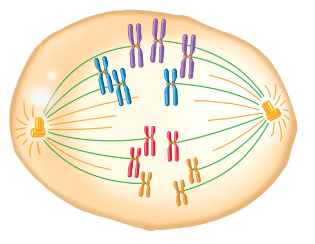
Meiotic Nondisjunction
A form of nondisjunction that produces haploid cells that have too many or too few chromosomes. If such a gamete participates in fertilization, the resulting individuals will have an abnormal chromosomal composition in all of its cells.
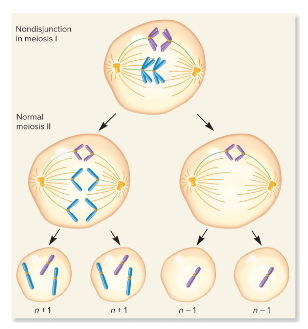
Meiosis 1 → all four gametes are abnormal
Meiosis 2 → 50% of gametes are abnormal and the other 50% are normal
What is the difference between nondisjunction in meiosis 1 and meiosis 2?
Complete Nondisjunction
When all the chromosomes undergo nondisjunction and migrate to one daughter cell. It results in one diploid cell and one without chromosomes. The diploid cell can participate in fertilization with a normal gamete, yielding a triploid individual.
Mitotic Nondisjunction
Nondisjunction in which the sister chromatids separate improperly, leading to trisomic and monosomic daughter cells.

Chromosome Loss
This occurs when one of the sister chromatids does not migrate to a pole, leading to a normal and monosomic daughter cell.
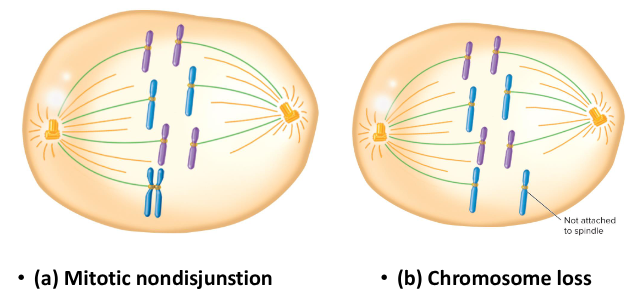
Mosaicism
This occurs when genetic abnormalities occur after fertilization. The organism contains a subset of cells that are genetically different from the rest of the organism. The size and location of the region depends on the timing and location of the original abnormality. In extreme cases, an abnormality could take place early in development and the cell will become a precursor to a large segment of the organism.
Autopolyploidy
An increase in the number of sets within a single species. Caused by complete nondisjunction that produces an individual with one or more sets of chromosomes.
Alloploidy
The combining of chromosome sets from different species. This is often caused by interspecies crosses, usually between closely related species.
Allopolyploidy
When the number of chromosome sets increases in an alloploid.
Ex) An allotatraploid contains two complete sets of chromosomes from two different species.